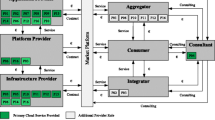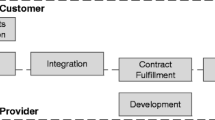Abstract
The acceleration of technical change in the fast moving electronics market increases the uncertainty and risk for IT providers. Influenced by new IT provisioning concepts such as cloud computing, providers are looking to identify stable guidelines and success factors within existing and new business models. The authors have conducted an intensive analysis of the business model characteristics of 45 providers in the cloud market that are critical to success. A cloud business model framework with 105 characteristics was used to systemize the business models, and the data was analyzed statistically in regard to indicators for success. The results revealed 42 success-related business model characteristics, and a cluster analysis led to three common combinations of characteristics that describe meta types of cloud business models. The most promising meta type is a specialized cloud provider with customer-oriented branch solutions, while small-scale newcomers with aggregation services experience difficulties to be competitive. To evaluate and verify the results and the success of each business model type, 12 expert interviews were conducted. The interview statements were aggregated and summarized to offer recommendations for action and a prediction for the success of cloud business models.





Similar content being viewed by others
References
Al-Debei MM, Avison D (2010) Developing a unified framework of the business model concept. Eur J Inf Syst (EJIS) 19(3):359–376
Anderberg MR (1973) Cluster analysis for applications. Academic Press, New York
Bacher J, Pöge A, Wenzig K (2010) Clusteranalyse: Anwendungsorientierte Einführung in Klassifikationsverfahren, 3rd edn. Oldenbourg, München
Baxter J, Eyles J (1997) Evaluating qualitative research in social geography: establishing ‘rigour’ in interview analysis. Trans Inst Br Geogr 22:505–525
Bettis RA, Hitt MA (1995) The new competitive landscape. Strateg Manag J (SMJ) 16(S1):7–19
Blashfield RK (1976) Mixture model tests of cluster analysis: accuracy of four agglomerative hierarchical methods. J Psychol Bull 83(3):377–388
Burkhart T, Krumeich J, Werth D, Loos P (2011) Analyzing the business model concept – a comprehensive classification of literature. In: Proceedings of the International Conference on Information Systems (ICIS) 32
Cohen SS, Zysman J, DeLong BJ (2000) Tools for thought: what is new and important about the “e-conomy”? Berkeley Roundtable on the International Economy. University of California, Berkeley
Creswell JW, Clark VL (2007) Designing and conducting mixed methods research. Sage, Thousand Oaks, CA
de Brentani U (1991) Success factors in developing new business services. Eur J Mark 25(2):33–59
Eccles RG (1991) The performance measurement manifesto. Harv Bus Rev 69(1):131–137
Ernst CH, Rothlauf F (2012) Potenzielle Erfolgsfaktoren von SaaS-Unternehmen. In: Proceedings of the Multikonferenz Wirtschaftsinformatik (MKWI)
Faust D (1982) A needed component in prescriptions for science: empirical knowledge of human cognitive limitations. Sci Commun 3(4):555–570
Franz H, Kopp R (2004) Betriebliche Experteninterviews. Sozialwissenschaften und Berufspraxis 27(1):51–61
Gartner (2013) Hype cycle for emerging technologies 2013: Gartner’s 2013 hype cycle for emerging technologies maps out evolving relationship between humans and machines. http://www.gartner.com/newsroom/id/2575515
Gaskell G (2000) Individual and group interviewing. In: Bauer MW, Gaskell G (eds) Qualitative researching: a practical handbook. Sage, London, pp 38–56
Gläser J, Laudel G (2010) Experteninterviews und qualitative Inhaltsanalyse, 4th edn. Springer Fachmedien, Wiesbaden
Gordon RJ (2000) Does the “New Economy” measure up to the great inventions of the past? National Bureau of Economic Research. Working Paper 7833
Grupp H, Schubert T (2010) Review and new evidence on composite innovation indicators for evaluating national performance. Res Policy 39(1):67–78
Hayes B (2008) Cloud computing. Commun ACM 51(7):9–11
Hopf C (2004) Qualitative interviews: an overview. In: Flick U, von Kardoff E, Steinke I (eds) A companion to qualitative research. Sage, London, pp 203–208
Horsti A, Tolonen J, Brannback M (2004) Electronic business models: five cases from five industries. In: Proceedings of the European conference on information systems (ECIS)
Hsieh H, Shannon SE (2005) Three approaches to qualitative content analysis. J Qual Health Res 15(9):1277–1288
Ittner CD, Larcker DF, Meyer MW (2003) Subjectivity and the weighting of performance measures: Evidence from a balanced scorecard. Account Rev 78(3):725–758
Kirsch LJ (2004) Deploying common systems globally: the dynamics of control. Int J Inf Syst Res 15(4):374–395
Labes S, Erek K, Zarnekow R (2013a) Common patterns of cloud business models. In: Proceedings of the Americas conference on information systems (AMCIS) 19
Labes S, Erek K, Zarnekow R (2013b) Literaturübersicht von Geschäftsmodellen in der Cloud. In: Proceedings of the international conference on Wirtschaftsinformatik (WI) 11
Labes S, Hanner N, Zarnekow R (2015) Success factors of cloud business models. In: Proceedings of the European conference on information systems (ECIS) 23
Lambert SC, Davidson RA (2013) Applications of the business model in studies of enterprise success, innovation and classification: an analysis of empirical research from 1996 to 2010. Eur Manag J (EMJ) 31:668–681
Lee AH, Chen W, Chang C (2008) A fuzzy AHP and BSC approach for evaluating performance of IT department in the manufacturing industry in Taiwan. Expert Syst Appl 34(1):96–107
Leidecker JK, Bruno AV (1984) Identifying and using critical success factors. Int J Long Range Plan (LRP) 17(1):23–32
Liebhold R, Trinczek R (2009) Experteninterviews. VS Verlag für Sozialwissenschaften, Wiesbaden
Mayring P (2004) Qualitative content analysis. In: Flick U, von Kardoff E, Steinke I (eds) A companion to qualitative research. Sage, London, pp 266–269
Mell P, Grance T (2011) The NIST definition of cloud computing. National Institute of Standards and Technology (NIST) Computer Security. doi:10.6028/NIST.SP.800-145
Miles MB, Huberman AM (1994) Qalitative data analysis. Sage, London
Myers MD (1997) Qualitative research in information systems. MIS Q 21(June):241–242
Osterwalder A (2004) The business model ontology: a proposition in a design science approach. Thesis. Université de Lausanne
Osterwalder A, Pigneur Y, Clark T (2010) Business model generation: a handbook for visionaries, game changers, and challengers. Wiley, Hoboken
Peters TJ, Waterman RH (1982) In search of excellence: lessons from America’s best-run companies, 2nd edn. Profile, London
Punj G, Stewart DW (1983) Cluster analysis in marketing research: review and suggestions for application. J Mark Res 20(May):134–148
Rockart JF (1979) Chief executives define their own data needs. Harv Bus Rev 57(2):81–93
Rockart JF (1982) The changing role of the inf syst executive: a critical success factors perspective. Sloan Manag Rev 23(1):3–13
Schilling J (2006) On the pragmatics of qualitative assessment: designing the process for content analysis. Eur J Psychol Assess 22(1):28–37
Schoeffler S, Buzzell RD, Heany DF (1974) Impact of strategic planning on profit performance. Harvard University, Boston, MA, Graduate School of Business Administration, pp 137–145
Shafer SM, Smith HJ, Linder JC (2005) The power of business models. Bus Horizons 48:199–207
Staehler P (2002) Business models as an unit of analysis for strategizing. International Workshop on Business Models. http://www.hec.unil.ch/aosterwa/Documents/workshop/Draft_Staehler.pdf. Accessed 28 Aug 2016
Thomas DR (2006) A general inductive approach for analyzing qualitative evaluation data. Am J Eval 27(2):237–246
Vaughan L (2004) Exploring website features for business information. J Scientometr 61(3):467–477
Vaughan L, Yang R (2012) Web data as academic and business quality estimates: a comparison of three data sources. J Am Soc Inf Sci Technol (ASIS&T) 63(10):1960–1972
Veit D, Clemons E, Benlian A, Buxmann P, Hess T, Kundisch D, Leimeister JM, Loos P, Spann M (2014) Business models. Bus Inf Syst Eng 6(1):45–53
Venkatesh V, Brown SA, Bala H (2013) Bridging the qualitative-quantitative divide: guidelines for conducting mixed methods research in information systems. MIS Q 37(1):21–54
Walther S, Plank A, Eymann T, Singh N, Phadke G (2012) Success factors and value propositions of software as a service providers – a literature review and classification. In: Proceedings of the Americas conference on Inf Syst (AMCIS)
Wang F, Vaughan L (2014) Firm web visibility and its business value. J Internet Res (INTR) 24(3):292–312
Weinhardt C, Anandasivam A, Blau B, Borissov N, Meinl T, Michalk W, Stößer J (2009) Cloud computing – a classification, business models, and research directions. Bus Inf Syst Eng 1(5):391–399. doi:10.1007/s12599-009-0071-2
Wirtz BW (2010) Electronic business, 3rd edn. Gabler, Wiesbaden
Patton MQ (2005) Qualitative research. Wiley, New York
Zerdick A, Picot A, Schrape K, Artope A, Goldhammer K, Heger DK, Lange UT, Vierkant E, Lopez-Escobar E, Silverstone R (2001) Die Internet-Ökonomie: Strategien für die digitale Wirtschaft. Europ Commun Council Rep, 3rd edn. Springer, Berlin, Heidelberg
Zolnowski A, Boehmann T (2011) Business modeling for services: current state and research perspectives. In: Proceedings of the Americas conference on information systems (AMCIS) 17
Zott C, Amit R, Massa L (2011) The business model: recent developments and future research. J Manag (JoM) 37(4):1019–1042
Author information
Authors and Affiliations
Corresponding author
Additional information
Accepted after two revisions by Prof. Dr. Bichler.
Rights and permissions
About this article
Cite this article
Labes, S., Hanner, N. & Zarnekow, R. Successful Business Model Types of Cloud Providers. Bus Inf Syst Eng 59, 223–233 (2017). https://doi.org/10.1007/s12599-016-0455-z
Received:
Accepted:
Published:
Issue Date:
DOI: https://doi.org/10.1007/s12599-016-0455-z




